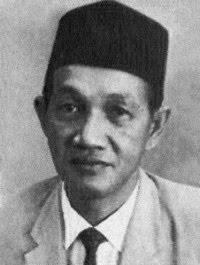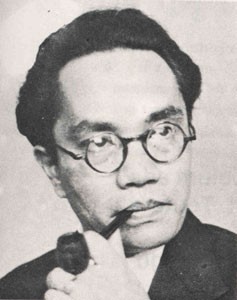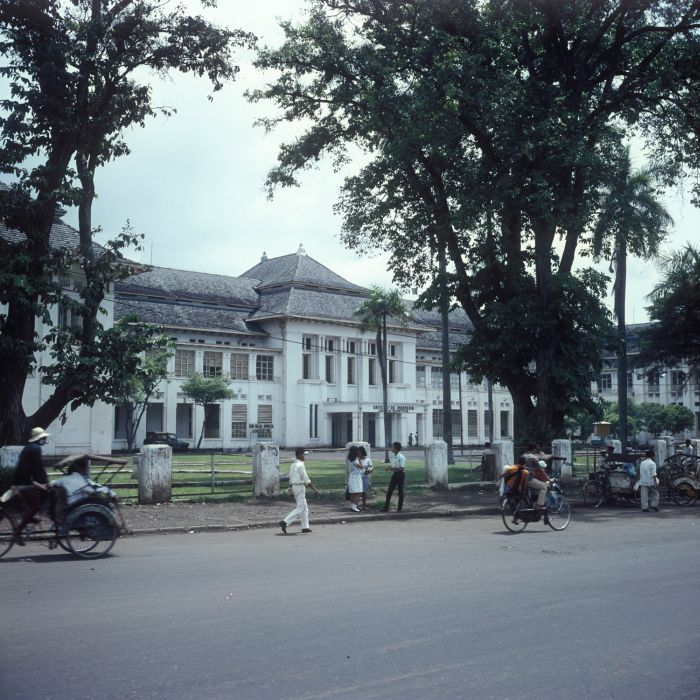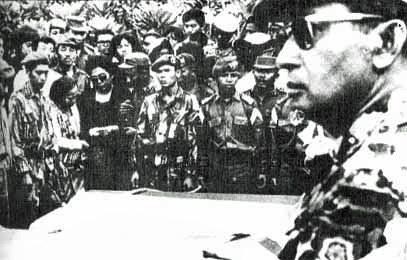|
Dipa Nusantara Aidit
Dipa Nusantara Aidit (born Ahmad Aidit; 30 July 1923 – 22 November 1965) was an Indonesian communist politician, who served as General Secretary of the Communist Party of Indonesia (PKI) from 1951 until his summary execution during the mass killings of 1965–66. Born on Belitung Island, he was nicknamed "Amat". Aidit was educated in the Dutch colonial system. Biography Aidit was born Achmad Aidit in Tanjung Pandan, Belitung, 30 July 1923. He was the first son of four. His parents were Abdullah Aidit and Mailan. Achmad and his siblings studied at Hollandsche Inlandsch School. In early 1936, Achmad asked his father to continue his studies in Jakarta (then called Batavia). Achmad then attended Middestand Handel School, instead of Meer Uitgebreid Lager Onderwijs, because the registration had already been closed. For three years he lived in Cempaka Putih with his father's colleague. He moved to Senen and lived with his brother Murad who followed in Achmad's footsteps. Unwil ... [...More Info...] [...Related Items...] OR: [Wikipedia] [Google] [Baidu] |
List Of Deputy Speakers Of The People's Consultative Assembly ...
The following is a list of deputy speakers of the People's Consultative Assembly in Indonesia. See also * People's Consultative Assembly * List of speakers of the People's Consultative Assembly Notes References {{reflist Lists of political office-holders in Indonesia Politics of Indonesia Government of Indonesia Indonesia Indonesia, officially the Republic of Indonesia, is a country in Southeast Asia and Oceania between the Indian and Pacific oceans. It consists of over 17,000 islands, including Sumatra, Java, Sulawesi, and parts of Borneo and New Guine ... [...More Info...] [...Related Items...] OR: [Wikipedia] [Google] [Baidu] |
Dutch East Indies
The Dutch East Indies, also known as the Netherlands East Indies ( nl, Nederlands(ch)-Indië; ), was a Dutch colony consisting of what is now Indonesia. It was formed from the nationalised trading posts of the Dutch East India Company, which came under the administration of the Dutch government in 1800. During the 19th century, the Dutch possessions and hegemony expanded, reaching the greatest territorial extent in the early 20th century. The Dutch East Indies was one of the most valuable colonies under European rule, and contributed to Dutch global prominence in spice and cash crop trade in the 19th to early 20th centuries. The colonial social order was based on rigid racial and social structures with a Dutch elite living separate from but linked to their native subjects. The term ''Indonesia'' came into use for the geographical location after 1880. In the early 20th century, local intellectuals began developing the concept of Indonesia as a nation state, and set the stage ... [...More Info...] [...Related Items...] OR: [Wikipedia] [Google] [Baidu] |
Japanese Occupation Of The Dutch East Indies
The Empire of Japan occupied the Dutch East Indies (now Indonesia) during World War II from March 1942 until after the end of the war in September 1945. It was one of the most crucial and important periods in modern Indonesian history. In May 1940, Germany occupied the Netherlands, and martial law was declared in the Dutch East Indies. Following the failure of negotiations between the Dutch authorities and the Japanese, Japanese assets in the archipelago were frozen. The Dutch declared war on Japan following the 7 December 1941 Attack on Pearl Harbor. The Japanese invasion of the Dutch East Indies began on 10 January 1942, and the Imperial Japanese Army overran the entire colony in less than three months. The Dutch surrendered on 8 March. Initially, most Indonesians welcomed the Japanese as liberators from their Dutch colonial masters. The sentiment changed, however, as between 4 and 10 million Indonesians were recruited as forced labourers ('' romusha'') on economic deve ... [...More Info...] [...Related Items...] OR: [Wikipedia] [Google] [Baidu] |
Adnan Kapau Gani
Adnan Kapau Gani (16 September 1905 – 23 December 1968), often abbreviated as A. K. Gani, was an Indonesian politician. Born in West Sumatra, he spent much of his youth in Java, where he studied medicine and became involved with the nascent nationalist movement before going to South Sumatra to work as a doctor. During the Indonesian National Revolution he served three terms as Minister of Welfare; two of these were concurrent with terms as a deputy prime minister. Afterwards Gani went to Palembang, South Sumatra, where he remained active in politics until his death. In November 2007 Gani was made a National Hero of Indonesia. Early life Gani was born in Palembajan, West Sumatra, west of Bukittinggi, on 16 September 1905. The son of a teacher, he finished his early studies in Bukittinggi in 1923 before going to Batavia (modern day Jakarta), first for his secondary studies and then to study medicine. He graduated from STOVIA ( nl, School tot Opleiding van Indische Artsen) ... [...More Info...] [...Related Items...] OR: [Wikipedia] [Google] [Baidu] |
Amir Sjarifudin
Amir Sjarifuddin Harahap ( EVO: Amir Sjarifoeddin Harahap; 27 April 1907 – 19 December 1948) was an Indonesian politician and journalist who served as the second prime minister of Indonesia from 1947 until 1948. A major leader of the left-wing during the Indonesian National Revolution, he previously served as Minister of Information from 1945 until 1946 and Minister of Defense from 1945 until 1948. Amir was born into the Sumatran aristocracy, and was educated at Leiden University. At Leiden, he became a member of the board of the Gymnasium student association in Haarlem, and was involved in the Batak student organization '' Jong Batak''. He returned to Indonesia due to family troubles, but continued his education at the '' Rechts Hogeschool'' in Batavia. After graduating, he became active in literary and journalist circles, joining the editorial board of the newspaper ''Panorama''. He also became involved with left-wing politics, and led a group of younger Marxist ... [...More Info...] [...Related Items...] OR: [Wikipedia] [Google] [Baidu] |
Gerindo
Gerindo (Indonesian People's Movement) ( id, Gerakan Rakyat Indonesia) was a pre-independence leftist nationalist political party in Indonesia. It adopted an anti-fascist stance, supporting the Dutch against the common threat from Empire of Japan, Imperial Japan, seeing this as a higher priority than immediate Indonesian independence. It subsequently joined with other nationalist parties to form the Indonesian Political Federation (GAPI). Background In 1931, Bonifacius Cornelis de Jonge became Governor-General of the Dutch East Indies and took a more hardline approach to Indonesian nationalist movements than his predecessor. As part of the clampdown, non-cooperative nationalist leader Sukarno was arrested in November 1934 followed by Mohammad Hatta, Hatta and Sutan Sjahrir, Sjahrir three months later. All were exiled, while Sukarno's Partindo, Indonesia party (Partindo) party, found itself leaderless. By 1935, as a result of legislation, detentions and police actions, the only non- ... [...More Info...] [...Related Items...] OR: [Wikipedia] [Google] [Baidu] |
Senen
Senen is a long-established urban district of Jakarta, Indonesia that has kept many tourist attractions such as two museums, the National Library of Indonesia and Gelanggang Remaja Senen, a quite narrow alley with old Chinese and similar style shops and restaurants. It was first developed in the 18th-century as ''Pasar Senen'' when governor Daendels established the ''bovenstad'' ("the upper town") as the new center of government of the fledgling city (then known as Batavia). Its kernel remains in what is now the formal lower-tier Village/Neighbourhood of Senen, within, the others being Kwitang, Kenari, Paseban, Kramat, and Bungur. This article covers the archetypal core and the whole Subdistrict of Central Jakarta. Toponym The name abbreviates Pasar Senen, "Monday Market". Limits The limits are a railway line to the east, Ciliwung River to the west, Jalan Pramuka Street to the south, and Jalan Abdul Rahman Saleh-Kwini II-Senen Raya IV (Jalan meaning road/street) to the nor ... [...More Info...] [...Related Items...] OR: [Wikipedia] [Google] [Baidu] |
Cempaka Putih
Cempaka Putih is a district of Central Jakarta, Indonesia. Cempaka Putih is roughly bounded by Jenderal Ahmad Yani bypass highway to the east, Pramuka boulevard to the south, Letjend Suprapto boulevard to the north, and a railway line to the west. The name "Cempaka Putih" derived from flowering plant white champaca. The office of Cempaka Putih is located in Jalan Rawa Kerbau III, Rawasari, Kelurahan Cempaka Putih Barat Kecamatan Cempaka Putih, Jakarta Pusat (10520). History Cempaka Putih district was formerly part of Senen district, later broken up in 1969 into Cempaka Putih district and Senen district. At first, Cempaka Putih district consisted of seven Administrative Village: Cempaka Putih Timur, Cempaka Putih Barat, Galur, Tanah Tinggi, Kampung Rawa, Johar Baru, and Rawasari. In 1993, the Administrative Village of Galur, Tanah Tinggi, Kampung Rawa, and Johar Baru was separated to form the district of Johar Baru ("New Johar"). The Administrative Village of Cempaka Putih Barat ... [...More Info...] [...Related Items...] OR: [Wikipedia] [Google] [Baidu] |
Jakarta
Jakarta (; , bew, Jakarte), officially the Special Capital Region of Jakarta ( id, Daerah Khusus Ibukota Jakarta) is the capital and largest city of Indonesia. Lying on the northwest coast of Java, the world's most populous island, Jakarta is the largest city in Southeast Asia and serves as the diplomatic capital of ASEAN. The city is the economic, cultural, and political centre of Indonesia. It possesses a province-level status and has a population of 10,609,681 as of mid 2021.Badan Pusat Statistik, Jakarta, 2022. Although Jakarta extends over only , and thus has the smallest area of any Indonesian province, its metropolitan area covers , which includes the satellite cities Bogor, Depok, Tangerang, South Tangerang, and Bekasi, and has an estimated population of 35 million , making it the largest urban area in Indonesia and the second-largest in the world (after Tokyo). Jakarta ranks first among the Indonesian provinces in human development index. Jakarta's busin ... [...More Info...] [...Related Items...] OR: [Wikipedia] [Google] [Baidu] |
Indonesian Mass Killings Of 1965–66
The Indonesian mass killings of 1965–66, also known as the Indonesian genocide, Indonesian Communist Purge, or Indonesian politicide ( id, Pembunuhan Massal Indonesia & Pembersihan G.30.S/PKI), were large-scale killings and civil unrest primarily targeting members of the Communist Party of Indonesia (PKI). Other affected groups included communist sympathisers, Gerwani women, ethnic Javanese Abangan, ethnic Chinese, atheists, alleged " unbelievers" and alleged leftists. It is estimated that between 500,000 to 1,000,000 people were killed during the main period of violence from October 1965 to March 1966. The atrocities were instigated by the Indonesian Army under Suharto. Research and declassified documents demonstrate the Indonesian authorities received support from foreign countries such as the United States and the United Kingdom. It began as an anti-communist purge following a controversial attempted ''coup d'état'' by the 30 September Movement. According to the most ... [...More Info...] [...Related Items...] OR: [Wikipedia] [Google] [Baidu] |
Communist
Communism (from Latin la, communis, lit=common, universal, label=none) is a far-left sociopolitical, philosophical, and economic ideology and current within the socialist movement whose goal is the establishment of a communist society, a socioeconomic order centered around common ownership of the means of production, distribution, and exchange which allocates products to everyone in the society.: "One widespread distinction was that socialism socialised production only while communism socialised production and consumption." Communist society also involves the absence of private property, social classes, money, and the state. Communists often seek a voluntary state of self-governance, but disagree on the means to this end. This reflects a distinction between a more libertarian approach of communization, revolutionary spontaneity, and workers' self-management, and a more vanguardist or communist party-driven approach through the development of a constitutional socialist state ... [...More Info...] [...Related Items...] OR: [Wikipedia] [Google] [Baidu] |
Abdullah Aidit
Abdullah Aidit (23 October 1900 – 14 February 1969) was an Indonesian politician and civil servant who served as a member of the Provisional People's Representative Council. He was the father of D. N. Aidit, chairman of the Indonesian Communist Party who was executed in 1965 following the 30 September Movement. Early life and education Abdullah was born in Tanjung Pandan on 23 October 1900. He was the son of Haji Ismail, a fishery businessman in Belitung. He worked as a forest ranger, and due to his family connections he managed to put all his eight children to school at Hollandsch-Inlandsche School. He was active in the local Islamic community, founding a local Islamic education institution. Two of his sons, Achmad Aidit and Murad Aidit, studied in Batavia, at a significant cost to the family's finances. When Achmad Aidit wanted to change his name, Abdullah resisted, primarily because he did not want to handle administrative problems associated with a change of name. He eventu ... [...More Info...] [...Related Items...] OR: [Wikipedia] [Google] [Baidu] |





